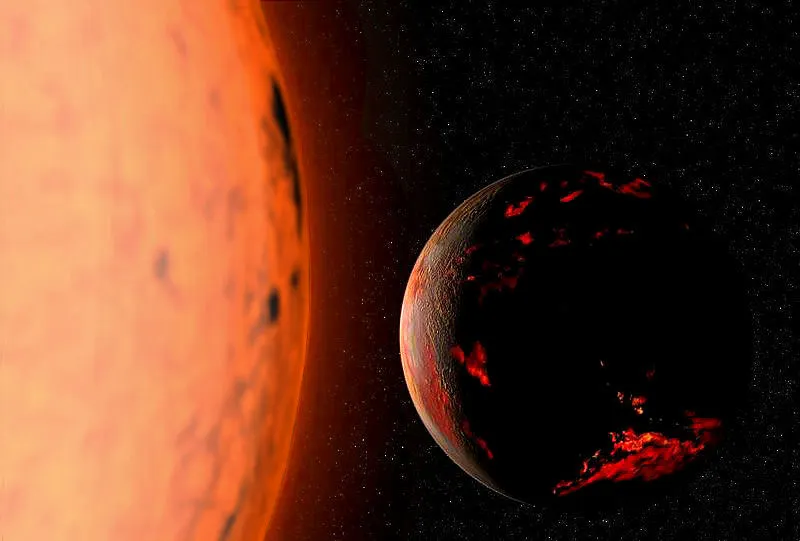"As the Sun becomes a true red giant, the Earth itself may be swallowed or engulfed, but it will definitely be roasted as never before. However, it remains to be seen whether any of the effects of swallowing Mercury, Venus, or even possibly Earth will be noticeable by a distant alien civilization". (BigThink.com/At last: astronomers catch a star eating its innermost planet)
The planet fell into a star that it orbited, or the nova eruption of a dying star destroyed the planet. That thing proved expectations that stars can eat their planets. At least when they start to expand to red giants. In other situations, the nova eruption from the dying star can destroy the entire planetary system. The star that ate its planet was the sun-type star that ran out of its fuel. And then the Nova eruption destroyed the planet near that star.
But there is the possibility that things like gravitation brake will cause a situation in which the planet falls into its sun. The situation could be that other planets in a very small solar system that formed around a red dwarf can brake one of its planets that are orbiting in another direction than the rest of the system. The gravitational brake that causes that planet's speed in its orbiter slows can slow planets around big stars.
The monster flares in binary star systems also can destroy planets. One of the reasons for the monster's flares is radiation that comes from the dominating part of the binary star. That kind of radiation can heat the other participant of those solar systems. And sometimes the FRB (Fast Radio Burst) is suspected as the reason why some orange- and red dwarfs eruptions are so powerful.
Normally, red dwarfs follow a certain cycle in their eruptions, but those eruptions start without warnings. There is some kind of outside energy effect that increases power production. And things that can increase energy production are the FRB and GRB (Gamma-Ray Bursts). The energy pike that comes from somewhere is very thin, and it's hard to see outside its track.
Above:) Triton's nitrogen geysers
Urbain Le Verrier (1811-1877) and his hypothesis about the Vulcan planet are almost so well known as the planet Neptune that Urbain Le Verrier found.
Was misunderstanding of the Vulcan planet just an error that spacetime curvature and time dilation near the Sun caused? Urbain Le Verrier didn't know about time dilation. And that made him calculate the orbiting time of Mercury wrong. Finally, Albert Einstein understood, why there was a difference between observations and calculations in Marcury's trajectory and orbital times.
There is a myth about Vulcan, the (probably) fictional planet inside Mercury's orbiter. One of the suggestions for reasons that nobody has ever seen that planet is that planet Vulcan just fell into the sun. That thing means that Urbain Le Verrier didn't lie about that planet. But in most sources, the Vulcan is claimed as a hoax. If the hypothetical Vulcan planet was the Ceres-size asteroid that fell into the sun. Nobody can prove or disprove that Urbain Le Verrier lied about Vulcan.
Urbain Le Verrier (1811-1877)
Maybe Urbain Le Verrier just made mistakes because he didn't know the curvature of spacetime. The differences between observations and calculations in Mercury's orbiting time caused the need to make a new theory that repairs to the Theory of Special Relativity. And that was the beginning of the Theory of General Relativity.
And anyway, Urbain Le Verrier found Neptune. The thing that makes Neptune interesting is that there is some kind of anomalies or non-matching points between that planet's calculated and real trajectory. The reason for those anomalies could be the curvature of spacetime. And that's why planet X or the ninth planet is so interesting.
Planet Nine is also a hypothetical object. And somebody suggested that there is some kind of black hole in our solar system. But nobody saw the thing, that caused the curvature of spacetime in that area. That thing could be a glimpse of dark matter, or it can be a yet unknown particle cloud.
Or in the wildest theories, the wormhole travels near that planet. The wormholes or GRB (Gamma-Ray Burst) type of phenomenon can cause the nitrogen geysers on Neptune's Triton moon. The reason for those geysers is that something pumps energy into that moon. If that moon is full of fission elements there must be lots of super-ionized ice because that radiation would push the molecules in ice to the lines.
But the thing is that if the calculations were astronomers tried to calculate Mercury's orbiting time by using classic models, the curvature of spacetime can cause those anomalies. Einstein saw differences between observations of Mercury's orbiting time and the results that he got by calculating Mercury's trajectory by using the Theory of Special relativity.
Einstein tried to make the calculations match with observations. But Einstein failed. And that thing was the beginning of Einstein's Theory of General relativity. The theory of General Relativity predicted the curvature of spacetime. So Urbain Le Verrier just didn't know the curvature of spacetime and time dilation near the sun, and that caused miscalculations.
https://bigthink.com/starts-with-a-bang/star-eats-planet/
https://scitechdaily.com/cosmic-cannibalism-astronomers-witness-star-devouring-planet-in-possible-preview-of-earths-ultimate-fate/
https://volcanohotspot.wordpress.com/2020/09/01/the-nitrogen-geysers-of-triton/
https://en.wikipedia.org/wiki/Urbain_Le_Verrier
https://en.wikipedia.org/wiki/Vulcan_(hypothetical_planet)







No comments:
Post a Comment
Note: Only a member of this blog may post a comment.